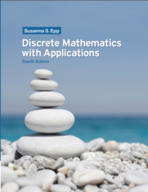Octal Notation: In addition to binary and hexadecimal,
Chapter 2, Problem 47E(choose chapter or problem)
In addition to binary and hexadecimal, computer scientists also use octal notation (base 8) to represent numbers. Octal notation is based on the fact that any integer can be uniquely represented as a sum of numbers of the form \(d \cdot 8^{n}\), where each n is a nonnegative integer and each d is one of the integers from 0 to 7 . Thus, for example,
\(5073_{8}=5 \cdot 8^{3}+0 \cdot 8^{2}+7 \cdot 8^{1}+3 \cdot 8^{0}=2619_{10}\)
a. Convert \(61502_{8}\) to decimal notation.
b. Convert \(20763_{8}\) to decimal notation.
c. Describe methods for converting integers from octal to binary notation and the reverse that are similar to the methods used in Examples 2.5 .12 and 2.5.13 for converting back and forth from hexadecimal to binary notation. Give examples showing that these methods result in correct answers.
Text Transcription:
d dot 8^n
5073_8=5 dot 8^3+0 dot 8^2+7 dot 8^1+3 dot 8^0=2619_10
61502_8
20763_8
Unfortunately, we don't have that question answered yet. But you can get it answered in just 5 hours by Logging in or Becoming a subscriber.
Becoming a subscriber
Or look for another answer
